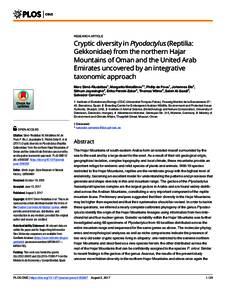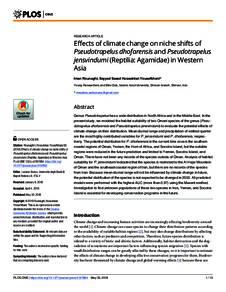وثيقة
Cryptic diversity in ptyodactylus (reptilia: gekkonidae) from the northern Hajar mountains of Oman and the United Arab Emirates uncovered by an integrative taxonomic approach.
المعرف
DOI: 10.1371/journal.pone.0180397
المصدر
PLoS ONE. v. 12, 8, e0180397
المساهمون
Metallinou, Margarita., مؤلف
de Pous, Philip., مؤلف
Els, Johannes., مؤلف
Jayasinghe, Sithum., مؤلف
Pentek-Zakar, Erika., مؤلف
Wilms, Thomas., مؤلف
Al-Saadi, Saleh., مؤلف
Carranza, Salvador., مؤلف
الدولة
France
الناشر
Public Library of Science.
ميلادي
2017-08-01
اللغة
الأنجليزية
الملخص الإنجليزي
The Hajar Mountains of south-eastern Arabia form an isolated massif surrounded by the sea to the east and by a large desert to the west. As a result of their old geological origin, geographical isolation, complex topography and local climate, these mountains provide an important refuge for endemic and relict species of plants and animals. With 19 species restricted to the Hajar Mountains, reptiles are the vertebrate group with the highest level of endemicity, becoming an excellent model for understanding the patterns and processes that generate and shape diversity in this arid mountain range. The geckos of the Ptyodactylus hasselquistii species complex are the largest geckos in Arabia and are found widely distributed across the Arabian Mountains, constituting a very important component of the reptile mountain fauna. Preliminary analyses suggested that their diversity in the Hajar Mountains may be higher than expected and that their systematics should be revised. In order to tackle these questions, we inferred a nearly complete calibrated phylogeny of the genus Ptyodactylus to identify the origin of the Hajar Mountains lineages using information from two mitochondrial and four nuclear genes. Genetic variability within the Hajar Mountains was further investigated using 68 specimens of Ptyodactylus from 46 localities distributed across the entire mountain range and sequenced for the same genes as above. The molecular phylogenies and morphological analyses as well as niche comparisons indicate the presence of two very old sister cryptic species living in allopatry: one restricted to the extreme northern Hajar Mountains and described as a new species herein; the other distributed across the rest of the Hajar Mountains that can be confidently assigned to the species P. orlovi. Similar to recent findings in the geckos of the genus Asaccus, the results of the present study uncover more hidden diversity in the northern Hajar Mountains and stress once again the importance of this unique mountain range as a hot spot of biodiversity and a priority focal point for reptile conservation in Arabia.
ISSN
1932-6203
قالب العنصر
مقالات الدوريات



